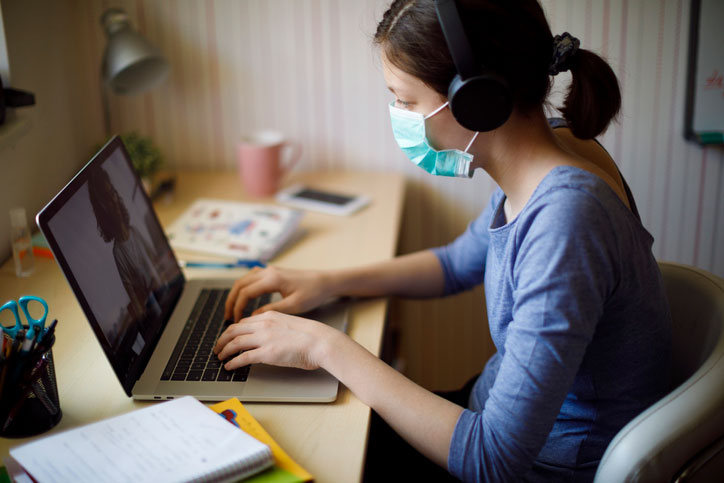How ABA Students Are Managing COVID-19 Stay-at-Home Orders and Preparing for How the Profession Will Be Different in a Post-Pandemic World
The practice of applied behavior analysis finds itself in a tough spot during the COVID-19 pandemic. With employment of ABA professionals concentrated in both educational and healthcare settings, it’s right at ground zero of the closures and layoffs that are hitting those sectors as non-essential services are being shuttered in the wake of stay-at-home orders coming down from state and municipal governments.
But at the same time, the field of behavior analysis has a lot of important contributions to make in the overall fight against the pandemic. It’s starting to become clear that ABA is one of the best tools available for understanding the behavioral aspects of epidemiology and coming up with effective ways to stem the spread.
At a time when simple behaviors around social distancing and hygiene are seen as the only way to mitigate the tremendous toll this virus is taking on human lives, you better believe ABA has a place in this fight.
It’s going to be a tough few months for many ABA providers, and they are scrambling to adjust to the reality of practice during a pandemic – and whatever may come next. And that’s to say nothing of the challenges today’s ABA students are currently dealing with. But in those challenges are vital opportunities to figure out what it’s going to take for your ABA practice to thrive in the post-pandemic world.
Crisis Management Calls for Behavioral Interventions
The BACB is Working with ABA Students to Find Work-Arounds for Supervised Fieldwork Requirements
Transitioning to Online-Only ABA Courses Will Require Some Behavior Adaptation
Dealing with the Challenges of Earning Your ABA Degree in Isolation
Build Your Skills For a Successful Career in the Post-Pandemic World
ABAs Are in the Thick of the Healthcare and Education Crises… But a Quick Shift to Telehealth Keeps ABA Therapy Available to Those Who Need It
COVID-19 has exposed some significant cracks in the healthcare industry in the United States, even as the heroism of the healthcare professionals rising to the occasion in these dark days outshines those underlying issues.
While critical care staff in healthcare are being overwhelmed treating those suffering from the worst effects of COVID-19, the same strain on resources has forced organizations to cut off many non-critical procedures and treatments, leading to widespread furloughs and layoffs. ABAs, assistant ABAs and RBTs are among those who have been affected.
And as if that weren’t enough, school systems, the other major employer of ABA professionals, were among the first to be shut down in response to the COVID-19 outbreak, and are likely to be among the last institutions to reopen once the pandemic runs its course. In the meantime, behavior analysts and support staff are either finding themselves furloughed or having to adapt to providing services remotely like other educators – that is, if they’re lucky enough to work for a district that has been effective in transitioning curriculum and services online.
Private practices have been impacted as well. In some states, ABA is listed as an essential service and practices have been allowed to remain open. Many providers have opted to close anyway, considering the expanded risk to both staff and clients.
But ABA is also a field where direct contact can be the least important part of treatment. The daily activities and actions of patients and those around them are pivotal. So ABA therapists can still provide guidance, consultation, and counseling remotely in many cases, to keep both their businesses open and patients on track.
Through a variety of online tools like GoToMeeting, Zoom for Healthcare, Skype, and Google Hangouts, therapists have been able to continue their work with any client that is willing and able to make the same kind of adjustments and switch to online therapy sessions.
Unfortunately, state laws can strictly limit your ability to practice remotely because of the fine print in some insurance legislation that gives insurers the ability to disallow coverage for remote services. Applied behavior analysts in Florida, Wisconsin, and Alabama, among others, are probably finding that out right about now.
The good news is that at the federal level, the U.S. Department of Health and Human Services has already notified providers that during the crisis it will use its discretion to suspend enforcement of federal regulations, including HIPAA rules, that would otherwise put restrictions on therapy provided using popular apps and services like FaceTime, Facebook Messenger, Google Hangouts, Skype and Zoom.
This means that practitioners located anywhere that doesn’t have these kinds of restrictions written into their state revised code can take their practices online and will continue to be reimbursed as usual.
Crisis Management Calls for Behavioral Interventions
Behavior analyst don’t just work in direct care and educational settings, however. Behavior analysis has long been an important part of public health initiatives, and that role has been spurred into action by COVID-19.
WHO’s Regional Office for Europe has initiated a broad-based study and tool for uncovering behavioral insights about the current outbreak, designed to quickly uncover public perceptions and behaviors so decision-makers around the world can fine-tune their coronavirus responses with the latest data.
Around the globe, behavior analysis is being used to develop evidence-based approaches to improving people’s perception of risk and correcting misconceptions, reducing stigmas around necessary behaviors like mask-wearing, and prescribing recommended behaviors related disease mitigation and testing.
These efforts are likely to save lives over the course of the outbreak and build better systems for handling a second-wave outbreak that might rear its head before a vaccine is ready to be deployed.
The BACB is Working with ABA Students to Find Work-Arounds for Supervised Fieldwork Requirements Under COVID-19 Stay-at-Home Orders

It’s entirely possible that you’ll face some very real and maybe even showstopping problems when it comes to completing your degree program and qualifying for BCBA or BCaBA certification right now. The biggest threat might be one that isn’t in the headlines yet:
Both schools and the BACB (Behavior Analyst Certification Board) are aware the issue and working on a solution. Although the BACB hasn’t yet offered specific guidance on the matter, they have quickly moved to shift to online proctored testing for their certification exams. They are also exempting RBTs from existing supervision requirements for certification renewal, recognizing that those hours might be impossible to come by right now.
The BACB is still working out the details for how to handle other fieldwork requirements but are already signaling that they are likely to be flexible when it comes to the number of required interactions and total hours. Accredited institutions are likely to follow their lead.
If you were currently in the middle of a fieldwork placement, and no longer have any required courses that you need to fill, you may be a little stuck until the BACB grants an official exemption or provides a pathway for completing your fieldwork remotely.
Transitioning to Online-Only ABA Courses Will Require Some Behavior Adaptation of Your Own

If you think of the COVID-19 pandemic as an antecedent stimulus, then the closure of your campus-based applied behavior analysis program may represent a sort of organizational learned behavior. Of course, understanding that cause and effect relationship may not help you feel any better about suddenly becoming an online student when that wasn’t what you signed up for.
You’ll also find that there’s not going to be an easy way for you to modify that behavior writ large; if a vaccine is developed or a lengthy period of social distancing works, that may do it. But it’s also likely that the pandemic will result in long-term effects on both higher education and the practice of applied behavior analysis.
There are already plenty of ABA degree programs that are available primarily online, so the fact that you didn’t choose one of them in the first place means you probably weren’t interested in that style of learning. But that just means it’s time for you to make adjustments in your own behaviors.
Using Learning Management Systems to Study Applied Behavior Analysis
Most schools out there have been delivering curriculum online for years, whether in ABA or any other program they offer. If they’ve already been running ABA classes online, it will be a seamless transition on their end. If it’s a different kind of curriculum they’re used to offering remotely, then at least they already have a system in place that will support the transition.
Common Learning Management Systems (LMS) that colleges and universities use to deliver curriculum online include:
Each of them comes with a web-based interface and technology to handle common classroom requirements like:
- Streaming audio or video lectures and classes
- Assignment tracking and coursework upload portals
- Online discussion forums and chat
- Whiteboard features
All you need to access them is a moderately speedy internet connection and a web browser. Some LMS platforms are now integrating apps for native use on mobile devices as well.
Third party software tools like VoiceThread can be integrated into the LMS, allowing instructors to further customize the experience and make their video content interactive by overlaying video and audio commentary and questions, adding notes and highlights with a stylus, and creating an interactive text feed within videos where they can post questions and prompts.
Tools like Perusall can bring that same kind of interactivity and customization to pdfs and other documents by allowing professors to give a reading assignment interspersed with their own notes, questions, and prompts. This serves to make a meaningful connection between the reading material and the curriculum so students stay engaged and get the most out of it.
There are still courses in which old fashioned paper and pencil work still has a place for the many students who haven’t transitioned over to using a tablet and stylus exclusively. When working on assignments that require you to show your work, scanning apps like CamScanner or Scanbot provide the solution. Some of the biggest names in software are also now in on the action with apps like Adobe Scan and MS Office Lens. In the most basic sense, they all work the same: Students simply use the camera on their phones to capture an image of their work and submit it along with their assignments through the LMS. The basic version of the software is typically free and gives you all the functionality you’d need for basic scanning, but you can also unlock a whole suite of impressive features with any one of these if you’re interested in shelling out a little coin to upgrade.
If for some reason your school is not able to deliver the ABA curriculum through the LMS, don’t worry… there’s still plain old-fashioned e-mail that works just fine to communicate with your instructor or fellow students. Assignments can be mailed out, homework can be mailed back. And many instructors are cobbling together rudimentary online classrooms with a variety of off-the-shelf tools like:
How Online ABA Classes Work
Whatever platform your school chooses, your online classes will follow one of two different basic formats, or both:
- Synchronous – A synchronous course most closely mirrors the on-campus experience. Instructors and students all show up at the same time in an online venue, usually a video or audio stream, and the instructor delivers their lecture. A virtual whiteboard and other multimedia support demonstrations and notetaking, while two-way chat or conferencing features allow class participation.
- Asynchronous – This type of course is more foreign to on-campus students, but more flexible. It doesn’t require keeping a schedule for real-time class attendance; instead, the instructor may post class notes or a downloadable/streamable lecture that you can watch at any time day or night. You can still interact with instructors and fellow students through chat or forums if you have questions. You complete the assignments in your own time and upload them prior to a deadline.
While it takes some getting used to, asynchronous courses are one of the most popular features of online degree programs, and you may come to appreciate the flexibility. On the other hand, the rigidity of the synchronous style may be easier for you as you adjust to the new circumstances.
Both schools and instructors are working to be more flexible to help you get through this, however. Some schools are extending their selective drop periods, allowing you to put your courses on hold and hope the situation stabilizes by fall; others are allowing students to switch to pass/fail grading for their online courses to take some of the pressure off.
Handling the Technical Challenges of Online ABA Education
Participating in any of the above types of classes requires that you have an internet connection and the right hardware and software at home, however. Since you weren’t spending the last semester getting ready for online classes, you might be scrambling a little bit now to make sure you have all those tools.
Many schools are working overtime to lend a hand for students who don’t happen to have what they need. IT departments are setting up hardware loan programs, working out discounted or free software downloads, and in some cases distributing wifi hotspots for students who don’t have internet access.
If your school isn’t one of them, don’t worry… Amazon is still delivering! Break out the credit card and we’ll tell you what you need.
What Kind of Hardware Do You Need for Online Coursework?
Actually, the good news is that most LMS platforms are pretty easy on the requirements side. If you have or can get your hands on a Mac or PC computer of even semi-recent vintage, you are probably good to go.
There are some hardware devices that can make your online studies a little easier, though… and that you might want to consider even if you expect this period of online learning to be brief. Setting up a home office for online studies isn’t that different from putting together one that could support the delivery of telehealth services over the long term.
So consider investing in some other hardware resources:
- Large or multiple monitors – Being able to see what is going on in your online class without getting a migraine will be a lot easier if you have a large high-resolution monitor sitting on your desk. It’s also useful to have some extra screen real estate so you can both stream video and consult online or other references simultaneously.
- Quality webcam and microphone – Your classes may or may not require your immediate participation, but if you are delivering telehealth services, either for your supervised fieldwork or, eventually, as a practicing behavior analyst, people on the other end of the line need to be able to see you. Get a good quality webcam, with acceptable audio options, to make sure you can be both seen and heard when needed.
- Tablet or mobile device – Many ABA services are better served with a little mobility. Hauling around your webcam on a cord while working with an autistic twelve-year-old can be a chore. Having a tablet or mobile device that can get you out from behind the desk can make that work a lot easier.
What Kind of Software Do You Need for Online Coursework?
Unless your instructor tells you otherwise, most of the software you need for class will probably be wrapped right into the LMS platform. It’s somewhat common for classes to use standard office tools like Microsoft’s Office 365 or Adobe Acrobat. Your school should be able to get you student discounts on such software, however.
Beyond that, there are some other cheap or free software accessories that may be useful. Everything from in-class note taking to cutting off Instagram while you are trying to study can be taken care of with ingenious software tools like these:
Many college IT departments are putting together their own lists of recommended tools and configurations for the crisis, so don’t forget to check their website first.
Can You Still Get Other School Services During the COVID Lockdown?
If you were attending an on-campus program, chances are you were relying on more campus resources than just lecture halls. But schools complying with social distancing requirements are closing down all kinds of campus services, including:
- Writing centers
- Career planning services
- Health centers
- Libraries and computer labs
But they are also working overtime to figure out ways to deliver some or all of those services to remote students. In fact, your school’s LMS might be doing double-duty to connect you not just with your regular classes and instructors, but with counselors, career services, and digitized library collections.
Many schools are putting together resource pages to help their newly online students with getting all this figured out. They know what is happening in your area better than anyone, so check with them first!
Dealing with the Challenges of Earning Your ABA Degree in Isolation

While the nuts and bolts of delivering an online ABA education are complicated enough, the mental challenges may be the hardest to overcome. You’re probably concerned about your health, the health of family and friends, the long-term implications of COVID-19 on both the economy and the practice of applied behavior analysis and how that may impact your career.
You’ve got a lot on your plate with the general psychological challenges of life during a pandemic, and that doesn’t even account for the typical problems students in online classes experience; things like difficulty concentrating and time management and self-discipline issues.
You’re going to have to make some adjustments across the board to handle all of this at once. Fortunately, if there’s anything you should have learned so far in your ABA education, it’s that human behaviors are adjustable. So here are some ways you can get yourself on track to handle online studies for the duration of the crisis:
Behavior Analyst, Analyze Thyself!
Treat yourself as a clinical case; what aberrant behaviors are you engaging in during this difficult time that need to be corrected? Then, what techniques can you use from your toolset to correct them?
Set up systems in your day-to-day routines that reward the positive and prompt you to eradicate counterproductive feelings and actions. Whether it’s motivational signs stuck on post-its around your monitor or allowing yourself extra sprinkles on your ice cream each time you complete an online assignment, use the abilities of your profession to get you through the hard times!
Lean on Your Fellow ABA Students
You may be attending class in isolation, but that doesn’t mean you are alone. You are surrounded by other students and instructors who all got into the profession for the same reason you did: they want to help people!
Now, you are one of those people… don’t hesitate to reach out when you need some assistance, or even just for a little one-to-one conversation. You may end up not only getting the reassurance and help that you need, but also helping someone else out at the same time!
Use The Internet For Fun as Well as Work
Showing up in front of your computer every day just to study and slog through schoolwork is bound to create some negative association in your brain. But there is a whole world of internet content out there that is designed for fun, not just work. Since you’ve invested the time and money in getting a setup that you can use to perform your schoolwork, it’s probably also perfectly suited to an ongoing loop of cat videos, Pinterest boards of exotic tropical islands, and games, both solo and with friends.
The options to keep yourself amused are so endless that it’s actually a threat to your productivity! But with a little self-discipline and good judgement, you can use the tubes to keep yourself sane as well as getting some work done.
In time, the world will return to a sort of normal… maybe not what you were expecting when you started your ABA program, but one in which your skills will still be important and your talents will have been honed through the adversity of this period in isolation. Keep your chin up! Future clients will need you.
Build Your Skills For a Successful Career in the Post-Pandemic World

Beyond just the day-to-day studies that are involved in your ABA courses, now is a good time to prepare yourself for more long-term changes that are likely coming to applied behavior analysis after COVID-19 is finally put to bed. While therapists and students alike are making big changes to deal with the immediate issues, you shouldn’t assume that everything will just snap back to normal.
That means it’s a good idea to devote some time to considering the likely effects of the pandemic on ABA practice over the course of your career.
A Major Shift to Telehealth May Be Coming
With many industries being forced to quickly adapt to remote work, the practice could see much more widespread acceptance in the future. While the immediate advantage is just having the ability to offer important services to patients that need them, there are other efficiencies in telehealth work that have long been ignored, including:
- Eliminating travel time and costs
- The ability for practitioners to take on more patients
- Keeping sensitive patients in familiar environments for their therapy
Although it’s not a panacea, you could see more insurers and healthcare organizations supporting telehealth than ever before, and new pushes for state laws requiring payment for such services. So it’s a good idea to develop your own skills in that direction.
With More New Clients Come New Client Issues
The anxiety and stress that comes from the death and trauma of COVID-19 and from the difficulty of undergoing social isolation for an extended period is going to result in a burst of new patients over the next couple of years for ABA therapists. These mental issues are just as responsive to behavioral therapy as any other, so you can expect a surge of referrals once people are in a position to receive treatment.
In addition to the sheer numbers of new patients, you can expect some surge in numbers for specific types of disorders. Anxiety is an obvious one, but you could also get a jump in cases of OCD (the pandemic has turned us all into chronic hand washers; in some cases, that behavior may become disruptive) and phobias such as claustrophobia, agoraphobia, and germophobia. So it’s probably time to bone up on treatments specific to such issues before they start walking in the door.
Emphasis on Infection Control Procedures
Not all treatment will be remote, and when clinics and schools reopen, there’s going to be a new emphasis on sterilization and solid infection control practices. Many healthcare settings have already gone through this process, but you can expect it to be even more important going forward – schools and clinics are likely to see stringent new protocols put in place for both students and therapists.
Be thinking about how you will handle therapy sessions while maintaining safe practices, and how to disinfect your workstation between clients.
Healthcare as a whole may see some big changes in the wake of the pandemic, but you can rest assured that behavioral therapists will remain in-demand and as important as ever regardless of what else happens in the industry.
Considering the Long-Term Effects of COVID-19 on ABA Practice
It’s far too soon to predict the size or shape of any grand changes in the global healthcare system, but it’s fair to say they are coming. Applied behavior analysis will be swept up in those changes, which are likely to include everything from billing trends to liability and malpractice considerations.
As many experts are predicting a long-lasting cycle of periodic lockdowns until a vaccine is developed, many ABA services will only be able to be delivered remotely in many areas for some time to come. But a deeper change is also likely, and one that is more in the purview of applied behavior analysts: the psychological and behavioral effects that could come out of all of this.
The very real possibility exists that generations living through it all could become more conscious of infection control in general, but also more hesitant about close contact with other people. This presents ABAs with a unique challenge, but also an opportunity to draw upon the compassion, patience and caring that made applied behavior analysis the right career path for them long before the coronavirus outbreak.






